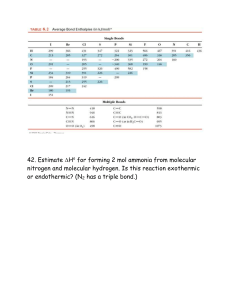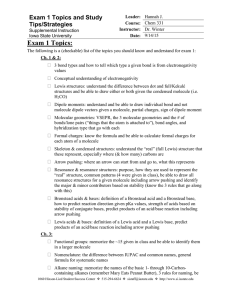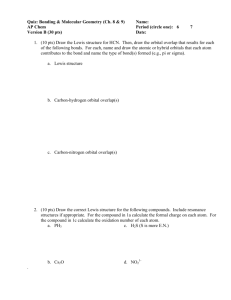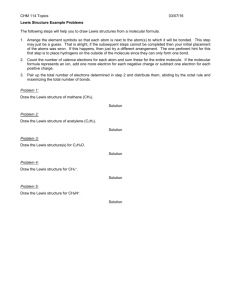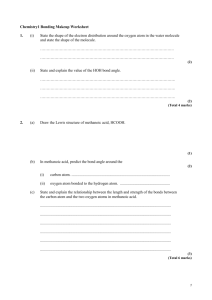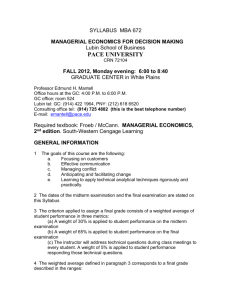Guide to Life in Orgo I
advertisement
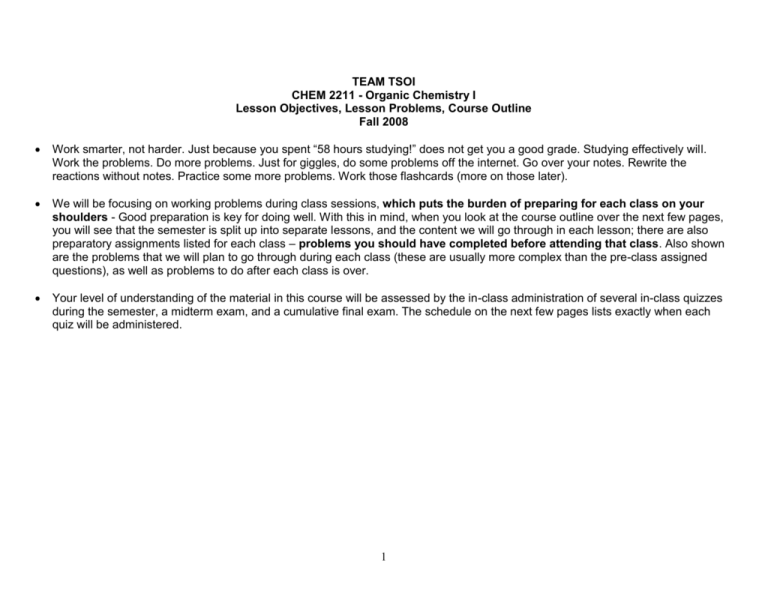
TEAM TSOI CHEM 2211 - Organic Chemistry I Lesson Objectives, Lesson Problems, Course Outline Fall 2008 Work smarter, not harder. Just because you spent “58 hours studying!” does not get you a good grade. Studying effectively will. Work the problems. Do more problems. Just for giggles, do some problems off the internet. Go over your notes. Rewrite the reactions without notes. Practice some more problems. Work those flashcards (more on those later). We will be focusing on working problems during class sessions, which puts the burden of preparing for each class on your shoulders - Good preparation is key for doing well. With this in mind, when you look at the course outline over the next few pages, you will see that the semester is split up into separate lessons, and the content we will go through in each lesson; there are also preparatory assignments listed for each class – problems you should have completed before attending that class. Also shown are the problems that we will plan to go through during each class (these are usually more complex than the pre-class assigned questions), as well as problems to do after each class is over. Your level of understanding of the material in this course will be assessed by the in-class administration of several in-class quizzes during the semester, a midterm exam, and a cumulative final exam. The schedule on the next few pages lists exactly when each quiz will be administered. 1 Lesson # Content Probs Before class Lesson 1 1.1 1.10 1.1 - 1.14 Lesson 2 1.11 1.12 1.15-1.17 Lesson Obj 1a Lesson Objectives Description Describe the distribution of electrons in an atom in its ground state. 1b Distinguish between core and valence electrons and write a ground state electron configuration for a given atom. 1c Convert a stereoview into a conventional drawing of a molecule using wedged, dashed, and normal lines. 1d Identify the number of covalent bonds an atom forms in a charged or neutral molecule to reach an octet. 1e Given a molecular or ionic formula, draw a Lewis and line-bond structure. 1f Describe electron sharing according to valence bond theory. 1g Describe bond angles around sp3-hybridized atoms. 1h Describe bond angles around sp2- and sp-hybridized atoms. 1i Distinguish between σ (sigma) and π (pi) bonds, and describe what orbital overlap leads to single, double, and triple bonds 1j Given a molecular or ionic formula, draw the Lewis structure, identify the hybridization of each atom, predict bond angles, and identify the molecular geometry around specified atoms. 1k Describe the hybridization of N, O, P, and S. 2a 1.L, 1.S 2b 2.1 - 2.6 2c Describe molecular orbital (MO) theory. Draw Kekulé, condensed, and skeletal structures and build the molecular model of a given compound. Probs During class Probs After class 1.25, 27, 30, 33 1.42, 46, 48-50 1.21, 35, 36a, 1.37, 39, 40b-d 1.40b Chapter 1 Review Questions: 24, 29, 33, 34, 40, 43, 52-54 2.1-2.8 Describe how bond polarity is attributable to electronegativity. 2d Differentiate among symmetrical covalent bonds, polar covalent bonds, and ionic attractions. 2e Discuss inductive effect as it relates to bond polarity. 2f Identify the dipole moment (μ), if any, of a molecule. 2g Calculate the formal charge of an atom in a molecule. 2h Draw resonance forms using electron-pushing arrows and identify the most stable (lowest energy) form. 2.9, 20, 25, 30, 32 2.21, 26, 29, 31, 33 2.35, 37a-b, 39, 43, 49 2.36, 37c-e, 38, 40, 50-52 Quiz #1- Ch 1 Lesson 3 2.7 2.12 2.10-13, 16a 2.L, 2.S 2.17, 18 3a Identify the Brønsted-Lowry or Lewis acid/base and the conjugate base/acid in a reaction. 3b Understand Ka, pKa, and given pKa values, predict relative acid strength and acid-base reactivity in a reaction. 3c Identify types of organic acids and recognize typical organic bases. 3d Identify Lewis acids/bases and using electron-pushing arrows, draw the reaction between a Lewis acid and Lewis base. 3e Describe noncovalent interactions (dipole-dipole forces, dispersion, hydrogen bonding). 3f Describe why substances are hydrophobic or hydrophilic or a combo of both Chapter 2 Review Questions: 19, 20, 26, 32, 39, 44a, 49, 53 2 Lesson # Content Probs Before class 3.1 - 3.5 3.1-9, 11b, 12a Lesson Obj Lesson Objectives Description Probs During class Probs After class 11a, 12b-c, 14, 21, 32, 34a-c 19, 22, 24, 27, 34d-f 16, 17, 42 48, 52 1c-f, 2c-d, 5b-c, 7, 24 20, 21, 26 12, 13, 16-18, 28 36, 41, 46 Lesson 4 Lesson 5 3.6 - 3.7 3.15 3.L , 3.S 4a Recognize and identify functional groups in an organic molecule and know the groups shown in Table 3.1 4b Given a molecular formula, draw constitutional isomers of alkanes and alkenes 4c Identify a specific carbon atom in an alkane as 1, 2°, 3° or 4°. 4d Name and draw the structure of a straight-chain or branched alkane. 4e Name the alkyl group derived from a straight or branched alkane, consisting of up to four carbon atoms. 4f Describe trends in boiling and melting points of alkanes in terms of intermolecular attractive forces. 5a Draw sawhorse representation and a Newman projection of staggered, eclipsed, anti, and gauche conformations of a given molecule. 5b Distinguish between torsional and steric strain, and describe sources of each. 5c Given energy cost data from Table 3.5, draw Newman projections for rotation about a C-C bond and then graph the potential energy vs. rotation, showing maxima and minima in the curve. Chapter 3 Review Questions: 13, 28, 32, 33c, 37a,c,d, 38, 40, 44 4.1 - 4.2 4.1a-b, 2ab, 3, 4, 5a 5d Write the name and draw structures for cycloalkanes 5e Identify cis-trans isomerism in cycloalkanes Lesson 6 4.3 - 4.9 Quiz #2- Ch 2 & 3 4.9, 10, 14, 15, 17a-b, 19 6a Describe ring strain, what evidence there is for it, and its impact on the reactivity of a cyclic molecule. 4.L, 4.S 6b Define and distinguish between angle, torsional and steric strain. 6c Draw Newman projections of conformations of cycloalkanes (with particular emphasis on cyclohexane) Identify axial and equatorial positions in the chair conformation of cyclohexane, before and after ringflip. Explain why the boat and twist-boat conformations of cyclohexane are higher in energy than the chair. 6d 6e 6f Identify and calculate 1,3-diaxial interactions (Table 4.1) in monosubstituted cyclohexanes; identify the low and high energy conformations. 6g Identify and calculate 1,3-diaxial interactions (Table 4.1) in disubstituted cyclohexanes; identify the low and high energy conformations. 6h Identify and describe cis and trans conformations in polycyclic molecules. Chapter 4 Review Questions: 22, 26, 30, 34, 40 3
